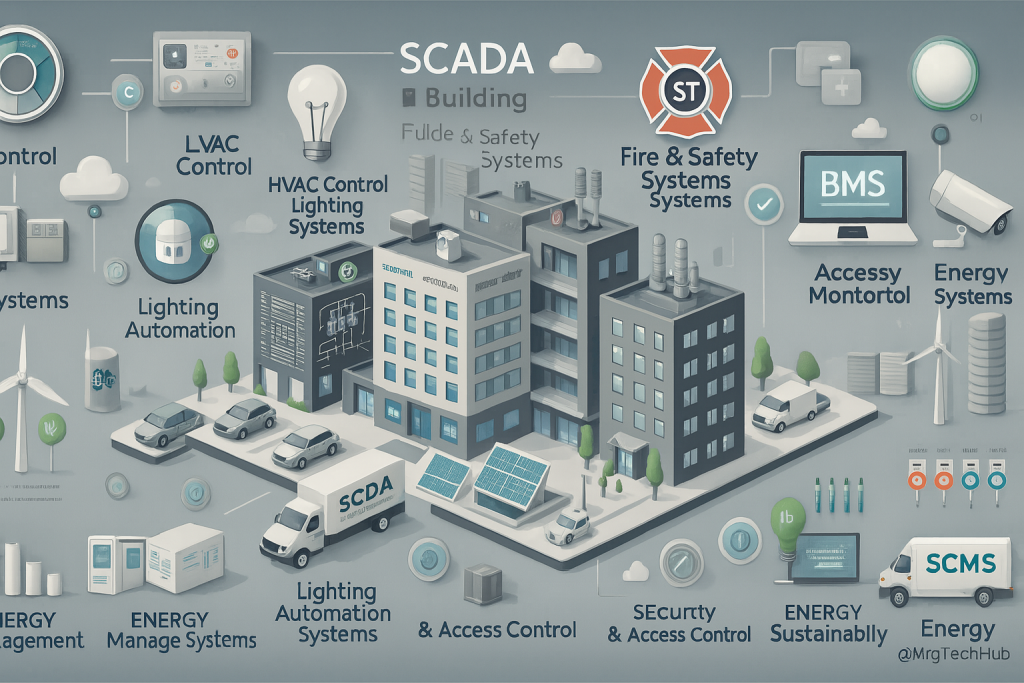SCADA System Applications in Building Management Systems (BMS)
SCADA (Supervisory Control and Data Acquisition) systems have become an integral part of Building Management Systems (BMS), helping to optimize energy consumption, improve security, and automate building operations. From HVAC control to access security, SCADA ensures efficient, cost-effective, and sustainable building management.

1. SCADA in HVAC Control
Heating, ventilation, and air conditioning (HVAC) systems are essential for maintaining indoor comfort in commercial and industrial buildings. SCADA automates temperature, humidity, and air quality control to enhance occupant comfort and reduce energy consumption.
Applications in HVAC Management

- Monitors temperature, humidity, and CO₂ levels in real time.
- Automatically adjusts heating or cooling to maintain desired conditions.

- Adjusts HVAC operations based on occupancy schedules.
- Uses predictive analytics to reduce unnecessary heating or cooling.

- Detects pollutants and ventilation issues.
- Ensures compliance with air quality regulations.
Key Benefits
✔️ Reduces energy costs by up to 30% through automation.
✔️ Enhances occupant comfort with precise climate control.
✔️ Extends HVAC system lifespan with predictive maintenance.
📌 Example: Smart Office Complex
- SCADA reduced energy consumption by 25% by optimizing HVAC operations based on real-time occupancy.
2. SCADA in Lighting Automation
Lighting is a major contributor to energy costs in commercial buildings. SCADA automates lighting schedules and integrates smart sensors to reduce energy waste.
Applications in Lighting Control
✅ Automated Lighting Schedules
- SCADA adjusts indoor and outdoor lighting based on time and occupancy.
- Ensures optimal brightness while minimizing energy use.
✅ Daylight Harvesting
- Sensors detect natural light and adjust artificial lighting accordingly.
- Reduces energy waste by using daylight when available.
✅ Motion-Activated Lighting
- Uses motion sensors to turn lights on or off automatically.
- Improves security while saving energy.
Key Benefits
✔️ Cuts lighting costs by up to 40%.
✔️ Enhances building sustainability by reducing electricity use.
✔️ Improves occupant productivity and comfort.
📌 Example: Green Energy Smart Building
- Automated lighting saved $100,000 annually in electricity costs.
3. SCADA in Fire and Safety Systems
SCADA plays a crucial role in fire detection and emergency response, ensuring rapid action in case of hazards. Beyond detection, these systems provide centralized visibility so that emergency teams can respond faster and more effectively.
Applications in Fire & Safety Management
✅ Automated Fire Detection
- Monitors smoke detectors, heat sensors, and gas leaks in real time.
- Sends alerts to fire control panels and emergency teams.
✅ Fire Suppression System Control
- SCADA automatically triggers sprinklers and fire suppression systems.
- Integrates with HVAC to control smoke ventilation.
✅ Emergency Evacuation Management
- Activates emergency lighting and exit signs.
- Alerts building occupants via public address systems.
Key Benefits
✔️ Improves fire response time, minimizing property damage.
✔️ Enhances occupant safety through automated emergency controls.
✔️ Ensures compliance with fire safety regulations.
📌 Example: High-Rise Commercial Tower
- SCADA reduced fire response time by 50%, improving building safety.
4. SCADA in Security and Access Control
SCADA helps monitor and control security systems, ensuring safe access and surveillance in buildings. With integration into BMS, building operators can monitor all entry points, alarms, and surveillance systems from a single dashboard.
Applications in Security Management
✅ Access Control
- SCADA manages doors, gates, and entry points with electronic access control.
- Restricts unauthorized access to secure areas.
✅ Surveillance and Intrusion Detection
- Integrates CCTV and motion detectors to monitor security.
- Alerts security teams in case of unauthorized entry or suspicious activity.
✅ Biometric and Smart Card Authentication
- Uses fingerprint or card-based authentication for high-security buildings.
- Logs entry and exit records for tracking personnel.
Key Benefits
✔️ Improves building security with real-time monitoring.
✔️ Prevents unauthorized access to restricted areas.
✔️ Provides audit trails for investigations.
📌 Example: Corporate Headquarters
- SCADA reduced unauthorized access incidents by 60% through smart access control.
5. SCADA in Energy Monitoring & Sustainability
SCADA enhances energy monitoring, helping buildings meet green building standards and reduce carbon footprints. Many smart buildings now use SCADA dashboards to benchmark energy use against international sustainability standards.
Applications in Energy Management
✅ Real-Time Energy Tracking
- Monitors electricity, water, and gas consumption.
- Detects energy wastage and optimizes efficiency.
✅ Integration with Renewable Energy
- SCADA manages solar panels, wind turbines, and battery storage.
- Optimizes renewable energy usage for cost savings.
✅ Carbon Footprint Reduction
- Tracks CO₂ emissions and energy efficiency metrics.
- Helps in meeting environmental regulations.
Key Benefits
✔️ Reduces operational costs through smart energy management.
✔️ Supports sustainability goals by lowering energy consumption.
✔️ Helps buildings earn LEED (Leadership in Energy and Environmental Design) certification.
📌 Example: Smart Shopping Mall
- SCADA cut energy usage by 30%, improving environmental sustainability.
In conclusion, SCADA is transforming Building Management Systems (BMS) by enhancing energy efficiency, security, safety, and automation. Modern buildings are becoming smarter and more responsive to both occupants and environmental conditions. From HVAC control to fire safety and renewable energy integration, SCADA ensures seamless building operations while reducing costs and improving sustainability. As cities move toward smart infrastructure, the role of SCADA-enabled BMS will only grow, making it a cornerstone of future-ready, intelligent buildings.
